The Indo-Islamic architecture began under influence of Islam in Indian subcontinent around the 7th century AD. Monuments and buildings reflecting native/regional Indic, Persian, central Asian, Arabic and Ottoman Turkish architecture style were extensively built by patrons of art and architecture in Medieval Period. Many of these styles are also influence by regional Indian architecture. It also Replace Indian Trabeate style with Arcuate style. Turks and Persians, who inherited wealth of various design from Sassanian and Byzantine empire, shaped and influenced the architecture.
Islamic buildings initially adapted the skills of a workforce trained in earlier Indian traditions to their own designs. Unlike most of the Islamic world, where brick tended to predominate, India had highly skilled builders well used to producing stone masonry of extremely high quality. Alongside the architecture developed in Delhi and prominent centres of Mughal culture such as Agra, Lahore and Allahabad, a variety of regional styles developed in regional kingdoms like the Bengal, Gujarat, Deccan, Jaunpur and Kashmir Sultanates. By the Mughal period, generally agreed to represent the peak of the style, aspects of Islamic style began to influence architecture made for Hindus, with even temples using scalloped arches, and later domes. This was especially the case in palace architecture. Following the collapse of the Mughal Empire, regional nawabs such as in Lucknow, Hyderabad and Mysore continued to commission and patronize the construction of Mughal-style architecture in the princely states.
Sultanate
Significant regional styles developed in the independent sultanates formed when the Tughlaq empire weakened in the mid-14th century, and lasted until most were absorbed into the Mughal Empire in the 16th century. Apart from the sultanates of the Deccan Plateau, Gujarat, Bengal, and Kashmir, the architecture of the Malwa and Jaunpur sultanates also left some significant buildings.
Delhi Sultanate
The start of the Delhi Sultanate in 1206 under Qutb al-Din Aibak introduced a large Islamic state to India, using Central Asian styles. The important Qutb Complex in Delhi was begun under Muhammad of Ghor, by 1199, and continued under Qutb al-Din Aibak and later sultans. The Quwwat-ul-Islam Mosque, now a ruin, was the first structure. Like other early Islamic buildings it re-used elements such as columns from destroyed Hindu and Jain temples, including one on the same site whose platform was reused. The style was Iranian, but the arches were still corbelled in the traditional Indian way. Alai Minar, a minaret twice the size of Qutb Minar was commissioned by Alauddin Khilji but never completed. Other examples include the Tughlaqabad Fort and Hauz Khas Complex.
 |
| Tomb of Muhammad Shah, Lodi Gardens |
Another very early mosque, begun in the 1190s, is the Adhai Din Ka Jhonpra in Ajmer, Rajasthan, built for the same Delhi rulers, again with corbelled arches and domes. Here Hindu temple columns (and possibly some new ones) are piled up in threes to achieve extra height. Both mosques had large detached screens with pointed corbelled arches added in front of them, probably under Iltutmish a couple of decades later. In these the central arch is taller, in imitation of an iwan.
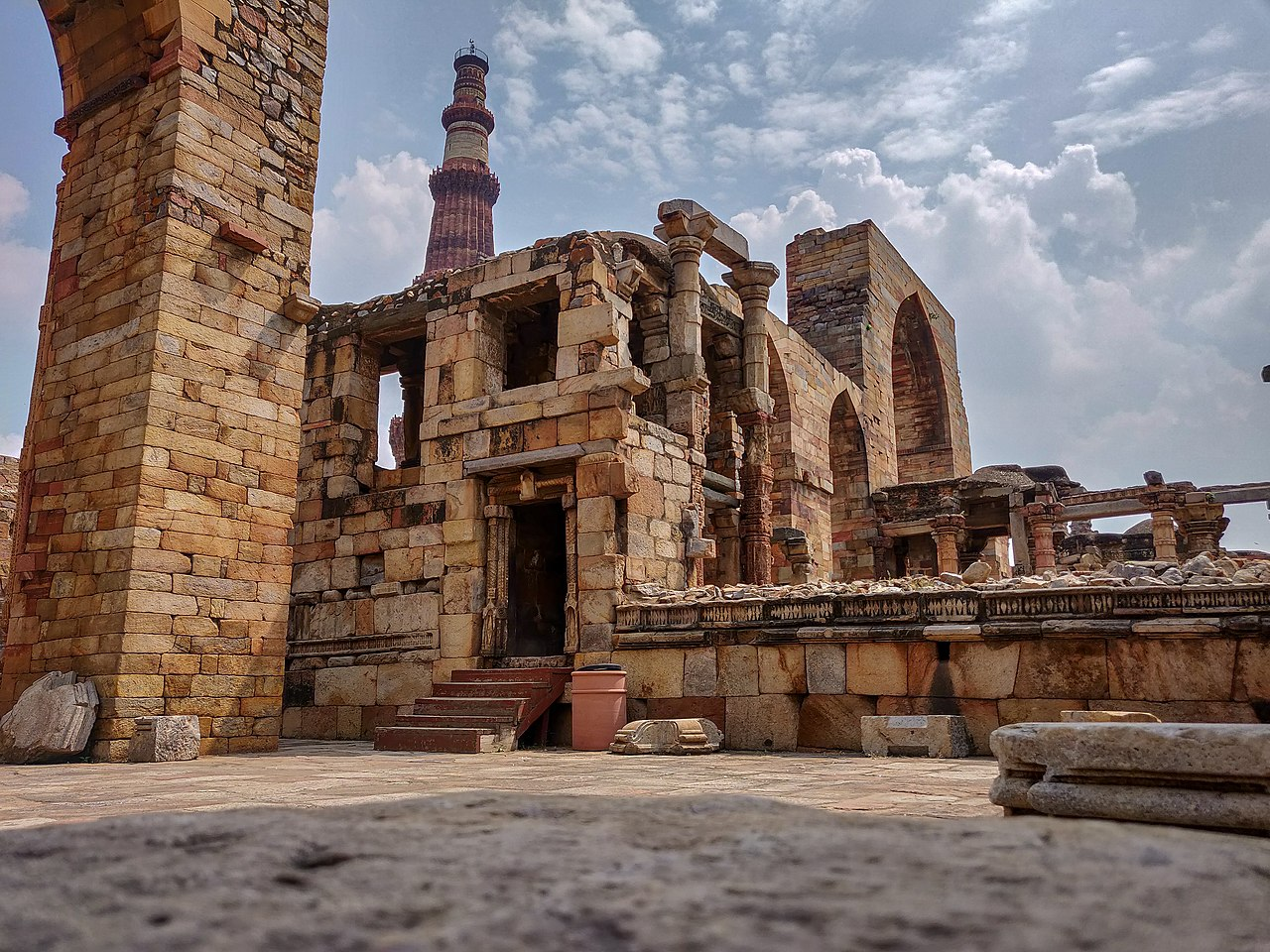 |
| Qutb complex |
At Ajmer the smaller screen arches are tentatively cusped, for the first time in India. By around 1300 true domes and arches with voussoirs were being built; the ruined Tomb of Balban (d. 1287) in Delhi may be the earliest survival. The Alai Darwaza gatehouse at the Qutb complex, from 1311, still shows a cautious approach to the new technology, with very thick walls and a shallow dome, only visible from a certain distance or height. Bold contrasting colours of masonry, with red sandstone and white marble, introduce what was to become a common feature of Indo-Islamic architecture, substituting for the polychrome tiles used in Persia and Central Asia. The pointed arches come together slightly at their base, giving a mild horseshoe arch effect, and their internal edges are not cusped but lined with conventionalized "spearhead" projections, possibly representing lotus buds. Jali, stone openwork screens, are introduced here; they already had been long used in temples.
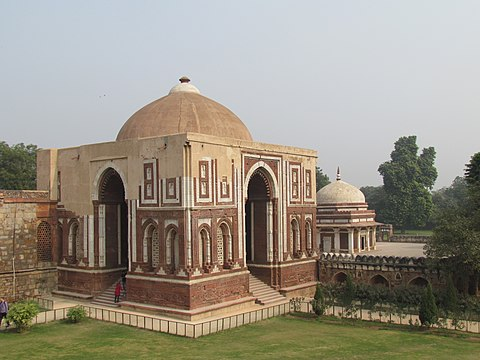 |
| Alai Darwaza |
By the time of Tughlaqs Islamic architecture in India had adopted some features of earlier Indian architecture, such as the use of a high plinth, and often mouldings around its edges, as well as columns and brackets and hypostyle halls. After the death of Firoz the Tughlaqs declined, and the following Delhi dynasties were weak. Most of the monumental buildings constructed were tombs, although the impressive Lodi Gardens in Delhi (adorned with fountains, charbagh gardens, ponds, tombs and mosques) were constructed by the late Lodi dynasty. The architecture of other regional Muslim states was often more impressive.
 |
| Lodi Gardens |
Deccan Sultanates
Dawood Shah of Bahamani Sultanate ruled for very short amount of time in 1378 but invented a new style of tomb, comprising two similar, domed structures on a single basement, a style not seen anywhere outside Kalaburagi. Firuz Shah who died in 1422 copied the double-chambered style but made his tomb much simpler. The black basalt door jambs reminiscent of temple pillars, the recessed arches bearing stucco floral work, arches bearing stucco floral work, and the chajjas borne on brackets that resemble those found in temples all become common features in later Bahmani architecture. Rangin Mahal in Bidar Fort, built by Ali Barid Shah in the 1500s. While the beautiful tile mosaics on some of its walls and the luminescent mother-of-pearl inlays on black basalt are Persian in style, its carved wooden pillars and brackets are clearly derived from local residential architecture.
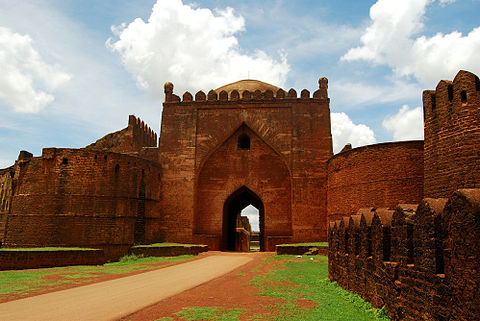 |
| Bidar Fort |
The main architectural activities for the Barid Shahi rulers were building garden tombs. The tomb of Ali Barid Shah (1577) is the most notable monument in Bidar. The tomb consists of a lofty domed chamber, open on four sides, located in the middle of a Persian four-square garden. The Rangin Mahal in Bidar, built during the reign of Ali Barid Shah, is a complete and exquisitely decorated courtly structure. Other important monuments in Bidar from this period are the tomb of Qasim II and the Kali Masjid.
 |
| Burial place of Ibrahim Adil Shah II |
Amongst the major architectural works in the Bijapur Sultanate, one of the earliest is the unfinished Jami Masjid, which was begun by Ali Adil Shah I in 1576. It has an arcaded prayer hall, with fine aisles, and has an impressive dome supported by massive piers. One of the most impressive monuments built during the reign of Ibrahim II was the Ibrahim Rouza which was originally planned as a tomb for queen Taj Sultana, but was later converted into the tomb for Ibrahim Adil Shah II and his family. This complex, completed in 1626, consists of a paired tomb and mosque.
 |
| Jami Masjid |
Notable buildings of the Bahmani and Deccan sultanates in the Deccan include the Charminar, Mecca Masjid, Qutb Shahi tombs, Madrasa Mahmud Gawan and Gol Gumbaz. The greatest monument in Bijapur is the Gol Gumbaz, the mausoleum of Muhammad Adil Shah, which was completed in 1656, and whose hemispherical dome measures 44 metres across.
 |
| Mecca Masjid |
One of the earliest architectural achievements of the Qutb Shahi dynasty is the fortified city of Golconda, which is now in ruins.In the 16th century, Muhammad Quli Qutb Shah decided to shift the capital to Hyderabad, 8 kilometres east of Golconda. Here, he constructed the most original monument in the Deccan, the Charminar, in the heart of the new city. This monument, completed in 1591, has four minarets, each 56 metres.
 |
| Golconda Fort |
Bengal Sultanate
The style of the Bengal Sultanate mostly used brick, with characteristic features being indigenous Bengali elements, such as curved roofs, corner towers and complex terracotta ornamentation. which were with blended. One feature in the sultanate was the relative absence of minarets. Many small and medium-sized medieval mosques, with multiple domes and artistic niche mihrabs, were constructed throughout the region.
 |
| Mihrabs |
These features are also seen in the Choto Sona Mosque (around 1500), which is in stone, unusually for Bengal, but shares the style and mixes domes and a curving "paddy" roof based on village house roofs made of vegetable thatch. Such roofs feature even more strongly in later Bengal Hindu temple architecture, with types such as the do-chala, jor-bangla, and char-chala. For larger mosques, Bengali architects multiplied the numbers of domes, with a nine-domed formula (three rows of three) being one option, surviving in four examples, all 15th or 16th century and now in Bangladesh, although there were others with larger numbers of domes.
 |
| Choto Sona Mosque |
The largest mosque in the Indian subcontinent was the 14th century Adina Mosque. Built of stone demolished from temples, it featured a monumental ribbed barrel vault over the central nave, the first such giant vault used anywhere in the subcontinent. The mosque was modelled on the imperial Sassanian style of Persia. The Sultanate style flourished between the 14th and 16th centuries. A provincial style influenced by North India evolved in Mughal Bengal during the 17th and 18th centuries. The Mughals also copied the Bengali do-chala roof tradition for mausoleums in North India.
 |
| Adina Mosque |
Although the description in Pandua, the ancient capital, shows mainly Persian culture in courts, we find one of the first attempts at fusing together the Islamic and Bengali style of architecture under Ilyas Shahi dynasty who ruled then. Under Jalaludin emerged the 'Bengal' style of mosques. With Jalaludin's reign we see the beginnings of a trend of Muslim ruling dynasty that grounded itself in local culture rather than seeking legitimacy from Delhi or Mecca. Upon his return to Delhi from his first Bengal expedition, Firoz Shah Tughlaq built Kotla Mosque, which bear a striking resemblance to the Bengal style.
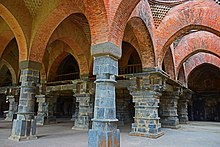 |
| Interior of the hypostyle hall of the Adina Mosque |
Kashmir
By 1339, Shams-ud-din Shah Mir of the Shah Mir dynasty established a sultanate encompassing the region of Kashmir (consisting of modern-day Gilgit-Baltistan, Azad Kashmir, Jammu and Kashmir, Ladakh, and Aksai Chin), allowing for the gradual Islamization of the region and the hybridization of Persianate culture and architecture with the indigenous Buddhist styles of Kashmir. In the capital at Srinagar in modern Indian-administered Kashmir, Sikandar Shah Mir constructed the Jamia Masjid, a large wooden congregational mosque that incorporates elements two cultures, that is, it has been erected in Persian style but its minar is topped with umbrella-shaped finial, which is in similitude with Buddhist pagoda structure, as well as the wooden Khanqah-e-Moulah mosque. Also in Srinagar are the Aali Masjid and the Tomb of Zain-ul-Abidin. Two 14th-century wooden mosques in Gilgit-Baltistan are the Chaqchan Mosque in Khaplu (1370) and the Amburiq Mosque in Shigar. Both have stone-built cores with elaborately carved wooden exterior galleries, at Amburiq on two levels, in an adaptation of traditional local styles.
 |
| Jama Masjid, Srinagar |
Gujarat sultanate
Under the Gujarat Sultanate, independent between 1407 and 1543, Gujarat was a prosperous regional sultanate under the rule of the Muzaffarid dynasty, who built lavishly, particularly in the capital, Ahmedabad, in its distinctive style of Indo-Islamic architecture. The sultanate commissioned mosques such as the Jami Masjid of Ahmedabad, Jama Masjid at Champaner, Jami Masjid at Khambhat, Qutbuddin Mosque, Rani Rupamati Mosque, Sarkhej Roza, Sidi Bashir Mosque, Kevada Mosque, Sidi Sayyed Mosque, Nagina Mosque and Pattharwali Masjid, as well as structures such as Teen Darwaza, Bhadra Fort and the Dada Harir Stepwell in Ahmedabad.
 |
| Ahmedabad |
The distinctive Indo-Islamic architecture style of Gujarat drew micro-architectural elements from earlier Maru-Gurjara architecture and employed them in mihrab, roofs, doors, minarets and facades. In the 15th century, the Indo-Islamic style of Gujarat is especially notable for its inventive and elegant use of minarets. They are often in pairs flanking the main entrance, mostly rather thin and with elaborate carving at least at the lower levels. Some designs push out balconies at intervals up the shaft; the most extreme version of this was in the lost upper parts of the so-called "shaking minarets" at the Jama Mosque, Ahmedabad, which fell down in an earthquake in 1819. This carving draws on the traditional skills of local stone-carvers, previously exercised on Hindu temples in the Māru-Gurjara and other local styles.
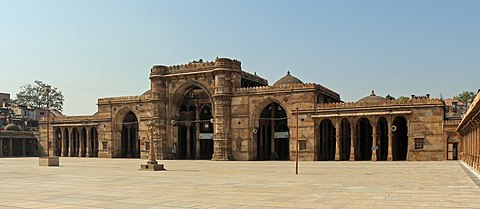 |
| Jama Mosque, Ahmedabad |
Indo-Islamic architecture style of Gujarat presages many of the architectural elements later found in Mughal architecture, including ornate mihrabs and minarets, jali (perforated screens carved in stone), and chattris (pavilions topped with cupolas).
 |
| Cupolas |
The Champaner-Pavagadh Archaeological Park, the 16th century capital of Gujarat Sultanate, documents the early Islamic and pre-Mughal city that has remained without any change.
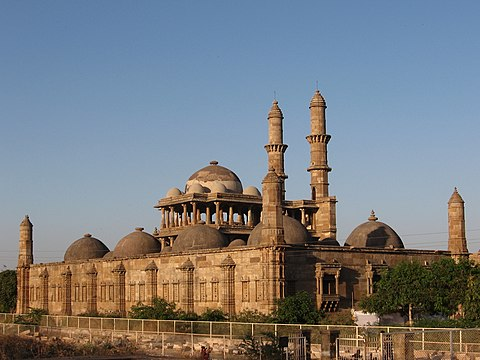 |
| Champaner-Pavagadh Archaeological Park |
Mughal Empire
Main article: Mughal architecture
The most famous Indo-Islamic style is Mughal architecture. Mughal art and architecture, a characteristic Indo-Islamic-Persian style flourished on the Indian subcontinent during the Mughal empire (1526-1857). This new style combined elements of Islamic art and architecture, which had been introduced to India during the Delhi Sultanate (1192-1398) and had produced great monuments such as the Qutb Minar, with features of Persian art and architecture. Its most prominent examples are the series of imperial mausolea, which started with the pivotal Tomb of Humayun, but is best known for the Taj Mahal.
 |
| Taj Mahal |
It is known for features including monumental buildings with large, bulbous onion domes, surrounded by gardens on all four sides, and delicate ornamentation work, including pachin kari decorative work and jali-latticed screens. Pietra dura or ‘Parchinkari’ rose to prominence under patronage of Emperors specially under Shah Jahan. Originating from Italy, it found its way to Mughal courts via trade route. It adapted to its present distinct feature of floral art by the hands of local artisans and Persian influence.
 |
| Bulbous domes on Tomb of Nisar Begum at Khusro Bagh |
Mughals brought in Persian style into Indian Architecture. The character and structure of Mughal buildings displayed a uniform character and structure. Some of the main features of the Mughal architecture are mentioned below.
- Large halls
- Very large vaulted gateways
- Delicate ornamentation
- Bulbous domes
- Slender Minarets with cupolas at the 4 corners
The Red Fort at Agra (1565-74) and the walled city of Fatehpur Sikri (1569-74) are among the architectural achievements of this time-as is the Taj Mahal, built as a tomb for Queen Mumtaz Mahal by Shah Jahan (1628-58). Employing the double dome, the recessed archway, the depiction of any animal or human-an essential part of the Indian tradition-was forbidden in places of worship under Islam.
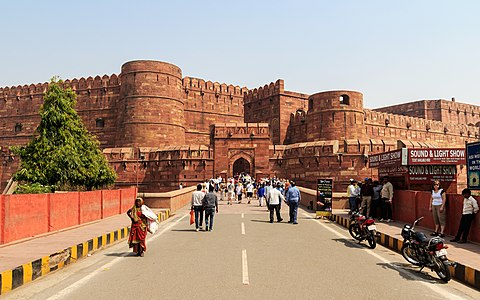 |
| Agra Fort |
Mughal architecture reached its zenith during the reign of the emperor Shah Jahan (1628-58), its crowning achievement being the magnificent Taj Mahal. This period is marked by a fresh emergence in India of Persian features that had been seen earlier in the tomb of Humayun. The use of the double dome, a recessed archway inside a rectangular fronton, and parklike surroundings are all typical of this period. Symmetry and balance between the parts of a building were always stressed, while the delicacy of detail in Shah Jahan decorative work has seldom been surpassed.
 |
| Safdarjung's Tomb is built in the late Mughal style for Nawab Safdarjung |
The Taj Mahal does contain tilework of plant ornaments. The architecture during the Mughal Period, with its rulers being of Turco-Mongol origin, has shown a notable blend of Indian style combined with the Islamic. Taj Mahal in Agra, India is one of the wonders of the world.
 |
| Tomb of I'timād-ud-Daulah is a Mughal mausoleum in Agra |
Mughal gardens are gardens built by the Mughals in the Islamic style. This style was influenced by Persian gardens. They are built in the char bagh structure, which is a quadrilateral garden layout based on the four gardens of Paradise mentioned in the Qur'an. This style is intended to create a representation of an earthly utopia in which humans co-exist in perfect harmony with all elements of nature.
 |
| Akbar's Tomb, Agra. Built with red sandstone by his son and grandson in 1605 to 1618 |
The quadrilateral garden is divided by walkways or flowing water into four smaller parts. Significant use of rectilinear layouts are made within the walled enclosures. Some of the typical features include pools, fountains and canals inside the gardens.
 |
| Humayun's Tomb, Delhi, the first fully developed Mughal imperial tomb, 1569-70 CE |




No comments:
Post a Comment